Fluid Properties | Civil Engineering SSC JE (Technical) - Civil Engineering (CE) PDF Download
| Table of contents |

|
| Definition of Fluid |

|
| Viscosity |

|
| Newton’s Law of Viscosity |

|
| Types of fluids |

|
Definition of Fluid
A fluid is a substance which flows continuously under the action of shear force (however small the force may be), as long as shear force is there the fluid moves or deforms.E.g: - Liquids, gases, vapour etc.
For a static fluid shear force = 0
Density or mass density (ρ):-
-Density or mass density of fluid is defined as the ratio of the mass of the fluid to its volume.
-The unit of mass density is kg per cubic meter i.e. kg/m3
-Density of water is maximum at 4ºC.
-Density of water at 4ºC = 1000 kg/m3
Specific Weight or Weight Density:
-Specific weight or weight density of a fluid is defined as the ratio of weight of a fluid to its volume.
-Thus, weight per unit volume of a fluid is called weight density.
-It is denoted by the symbol ‘w’.
-Mathematically,
-The value of specific weight of water is 9.81 X 1000 N/m3 in SI unit.
Specific Gravity or Relative Density:
-Specific gravity is defined as the ratio of the density (or weight density) of a fluid to the density (or weight density) of a standard fluid.
-For liquids, standard fluid is taken water and for gases, standard fluid is taken air.
-Specific gravity is also called relative density.
-It is dimensionless quantity and is denoted by symbol S.
-Mathematically,
-Specific gravity of mercury is 13.6.
Viscosity
-Viscosity is defined as the property of fluid which offers resistance to the movement of one layer of fluid over another adjacent layer of fluid.
-When two layers of a fluid distance ‘dy’ apart, move one over the another at different velocities, say u and u + du as shown in fig., the viscosity together with relative velocity causes a shear stress acting between the fluid layers.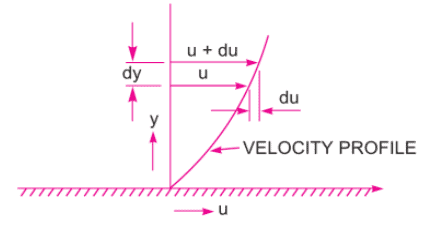 -The top layer causes a shear stress on the adjacent lower layer while the lower layer causes shear stress on the adjacent top layer.
-The top layer causes a shear stress on the adjacent lower layer while the lower layer causes shear stress on the adjacent top layer.
-This shear stress is proportional to the rate of change of velocity with respect to y.
It is denoted by symbol Τ (Tau).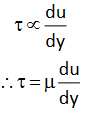 -Where μ (called mu) is the constant of proportionality and is known as the co-efficient of dynamic viscosity or only viscosity
-Where μ (called mu) is the constant of proportionality and is known as the co-efficient of dynamic viscosity or only viscosity
- represents the rate of shear strain or rate of shear deformation or velocity gradient.
represents the rate of shear strain or rate of shear deformation or velocity gradient.
-Viscosity is also defined as the shear stress required to produce unit rate of shear strain.
Unit:
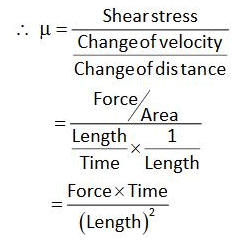
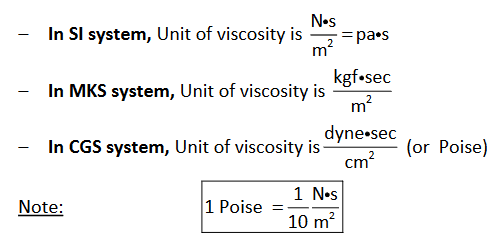
Newton’s Law of Viscosity
-Its states that the shear stress (Τ) on a fluid element layer is directly proportional to the rate of shear strain.
-The constant of proportionality is called the co-efficient of viscosity.
-Mathematically,

Types of fluids
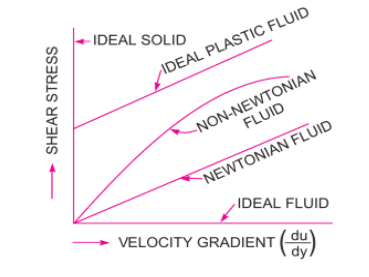
1. Ideal Fluid (Perfect Fluid)
-A fluid, which is incompressible and is having no viscosity, is known as ideal fluid.
-Ideal fluid is only an imaginary fluid because all the fluids, which exit, have some viscosity.
-Used in mathematical analysis and flow problems.
-Ideal fluid has no surface tension
2. Real Fluid
-Possess the properties such as viscosity, surface tension and compressibility.
-Offers resistance against flow.
-All the fluids in practice are real fluids.
3.Newtonian fluid
-A real fluid,in which the shear stress is directly proportional to the rate of shear strain(or velocity gradient), is known as the Newtonian fluid.
-Example:Water, Air, Thin motor oil
4. Non-Newtonian Fluid:
-A real fluid, in which the shear stress is not proportional to the rate of shear strain(or velocity gradient), is known as the non-Newtonian fluid.
-Example : Tooth Paste
5.Ideal-Plastic Fluid:
-A fluid, in which shear stress is more than the yield value and shear stress is proportional to the rate of shear strain(or velocity gradient), is known as ideal plastic fluid.
-Example : Sewage sludge
Surface Tension (s or σ):
-Surface tensions is due to cohesion only.
-Surface tension decrease with increase in temperature and it also act when fluid is at rest
-It is a surface phenomenon
-At critical point liquid and vapour are at same state thus surface tension is zero
swater = 0.0736 N/m at 20ºC
smercury = 4.51 N/m
(i) Pressure inside a liquid drop in excess of atmospheric pressure
-p=4s/d
p = Pressure intensity inside the droplet (in excess of the outside pressure)
d = Dia. of droplet
s = Surface tension of the liquid
-Equation shows that with increase of diameter of the droplet, pressure intensity inside the droplet decreases.
(ii) Soap bubble
-p=8s/d
(iii) Pressure inside a water droplet
-p=2s/d
Capillary Action:
-Capillarity is defined as a phenomenon of rise or fall of a liquid surface in a small tube relative to the adjacent general level of liquid when tube is held vertically in the liquid.
-The rise of the liquid surface is known as capillarity rise while the fall of liquid surface is known as capillarity depression or fall.
-It is expressed in terms of cm or mm of liquid.
-Its value depends upon the specific weight of the liquid, diameter of the tube and surface tension of the liquid.
Expression for Capillarity Rise:
h = rise in capillary
σ = surface tension of water & glass
d = diameter of tube
θ = angle of contact between the liquid and the material
-The value of θ between water and clean glass tube is approximately equal to zero and hence cosθ is equal to unity.
Compressibility :
It refers to change in volume/density due to change in pressure.
The compressibility is reciprocal of bulk modulus of elasticity (K).
Compressibility = 1/k
In compressible fluids the velocity of sound is given by
c = (K/ρ)1/2
C = velocity of sound in fluid, K = Bulk modulus,ρ=density
|
2 videos|133 docs|55 tests
|
FAQs on Fluid Properties - Civil Engineering SSC JE (Technical) - Civil Engineering (CE)
| 1. What is the definition of fluid? |  |
| 2. What is viscosity? |  |
| 3. What is Newton's Law of Viscosity? |  |
| 4. What are the different types of fluids? |  |
| 5. What are some common properties of fluids in civil engineering? |  |
















